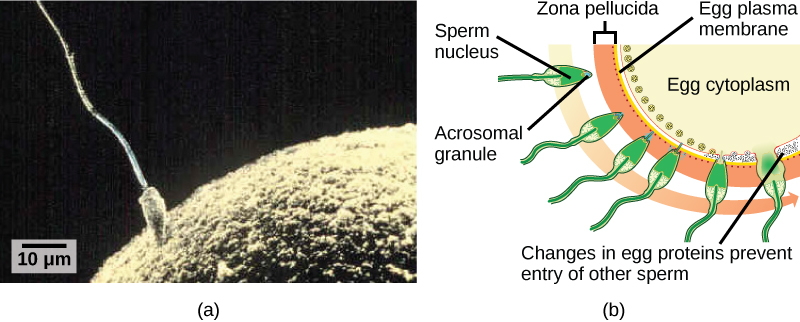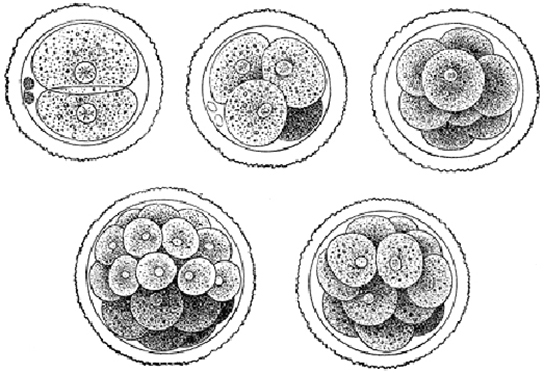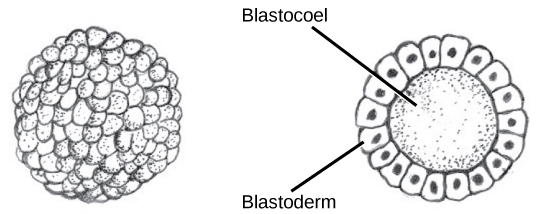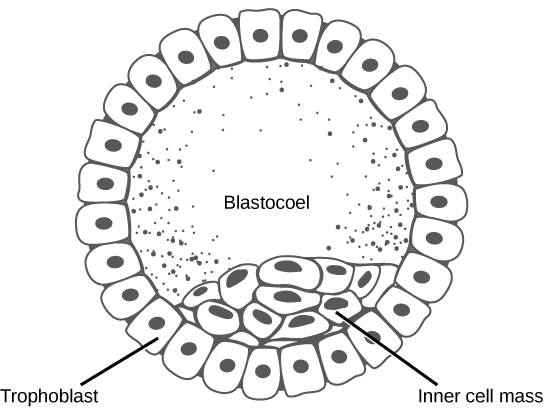43.6: 受精和早期胚胎发育
- Page ID
- 202573
培养技能
- 讨论受精是如何发生的
- 解释胚胎是如何由合子形成的
- 讨论分裂和胃化在动物发育中的作用
生物体从单细胞合子发育成多细胞生物的过程复杂且调节良好。 胚胎发育的早期阶段对于确保生物体的健康也至关重要。
受精
如图\(\PageIndex{1}\) a 所示,受精是配子(卵子和精子)融合形成合子的过程。 卵子和精子各包含一组染色体。 为了确保后代只有一组完整的二倍体染色体,只有一个精子必须与一个卵融合。 在哺乳动物中,卵受一层细胞外基质保护,该基质主要由称为透明带的糖蛋白组成。 当精子与 zona pellucida 结合时,会发生一系列生化事件,称为顶体反应。 在胎盘哺乳动物中,顶体含有消化酶,这些酶会引发糖蛋白基质的降解,保护卵子,使精子质膜与卵质膜融合,如图\(\PageIndex{1}\) b 所示。这两个膜的融合形成了一个开口精子核被转移到卵子中。 卵子和精子的核膜分解,两个单倍体基因组凝结形成二倍体基因组。

为了确保卵子受精的精子不超过一个,一旦卵膜的一个位置发生顶体反应,卵子就会在其他位置释放蛋白质,以防止其他精子与卵子融合。 如果这种机制失效,多个精子会与卵子融合,从而产生多精子症。 由此产生的胚胎在遗传上不可行,几天之内就会死亡。
Cleavage and Blastula 阶段
多细胞生物的发育始于单细胞合子,它经历快速的细胞分裂形成小泡状物。 快速的多轮细胞分裂被称为分裂。 分裂如图\(\PageIndex{2}\) a 所示。 在裂解产生 100 多个细胞后,胚胎被称为 blastula。 blastula 通常是围绕充满液体或蛋黄填充的空腔(blastocoel)的球形细胞层(blastocoel)。 哺乳动物在这个阶段形成一种叫做囊胚的结构,其特征是内部细胞团与周围的 blastula 不同,如图\(\PageIndex{2}\) b 所示。在分裂过程中,细胞分裂时质量没有增加;也就是说,一个大的单细胞合子分裂成多个较小的细胞。 blastula 中的每个细胞都被称为 blastomere。


分裂可以通过两种方式发生:holoblastic(全部)分裂或 meroblastic(部分)分裂。 分裂的类型取决于鸡蛋中蛋黄的含量。 在胎盘哺乳动物(包括人类)中,营养由母亲的身体提供,卵的蛋黄量非常少,会发生全细胞分裂。 其他物种,例如鸟类,在发育过程中卵中含有大量蛋黄来滋养胚胎,则会经历成细胞分裂。
在哺乳动物中,b lastula 在下一个发育阶段形成囊泡。 在这里,blastula 中的细胞分为两层:内部细胞团和称为滋养层的外层。 内部细胞团也被称为胚胎细胞,这种细胞团将继续形成胚胎。 在这个发育阶段,如图\(\PageIndex{3}\)所示,内部细胞团由胚胎干细胞组成,这些干细胞将分化为生物体所需的不同细胞类型。 滋养细胞将有助于胎盘并滋养胚胎。

胃食
典型的 blastula 是细胞球。 胚胎发育的下一个阶段是身体计划的形成。 blastula 中的细胞在空间上重新排列,形成三层细胞。 这个过程被称为胃化。 在胃化过程中,blastula 会自身折叠形成三层细胞。 这些层中的每一个都被称为生殖层,每个细菌层分为不同的器官系统。
三个细菌层,如图所示\(\PageIndex{4}\), are the endoderm, the ectoderm, and the mesoderm. The ectoderm gives rise to the nervous system and the epidermis. The mesoderm gives rise to the muscle cells and connective tissue in the body. The endoderm gives rise to columnar cells found in the digestive system and many internal organs.

Everyday Connection: Are Designer Babies in Our Future?

If you could prevent your child from getting a devastating genetic disease, would you do it? Would you select the sex of your child or select for their attractiveness, strength, or intelligence? How far would you go to maximize the possibility of resistance to disease? The genetic engineering of a human child, the production of "designer babies" with desirable phenotypic characteristics, was once a topic restricted to science fiction. This is the case no longer: science fiction is now overlapping into science fact. Many phenotypic choices for offspring are already available, with many more likely to be possible in the not too distant future. Which traits should be selected and how they should be selected are topics of much debate within the worldwide medical community. The ethical and moral line is not always clear or agreed upon, and some fear that modern reproductive technologies could lead to a new form of eugenics.
Eugenics is the use of information and technology from a variety of sources to improve the genetic makeup of the human race. The goal of creating genetically superior humans was quite prevalent (although controversial) in several countries during the early 20th century, but fell into disrepute when Nazi Germany developed an extensive eugenics program in the 1930's and 40's. As part of their program, the Nazis forcibly sterilized hundreds of thousands of the so-called "unfit" and killed tens of thousands of institutionally disabled people as part of a systematic program to develop a genetically superior race of Germans known as Aryans. Ever since, eugenic ideas have not been as publicly expressed, but there are still those who promote them.
Efforts have been made in the past to control traits in human children using donated sperm from men with desired traits. In fact, eugenicist Robert Klark Graham established a sperm bank in 1980 that included samples exclusively from donors with high IQs. The "genius" sperm bank failed to capture the public's imagination and the operation closed in 1999.
In more recent times, the procedure known as prenatal genetic diagnosis (PGD) has been developed. PGD involves the screening of human embryos as part of the process of in vitro fertilization, during which embryos are conceived and grown outside the mother's body for some period of time before they are implanted. The term PGD usually refers to both the diagnosis, selection, and the implantation of the selected embryos.
In the least controversial use of PGD, embryos are tested for the presence of alleles which cause genetic diseases such as sickle cell disease, muscular dystrophy, and hemophilia, in which a single disease-causing allele or pair of alleles has been identified. By excluding embryos containing these alleles from implantation into the mother, the disease is prevented, and the unused embryos are either donated to science or discarded. There are relatively few in the worldwide medical community that question the ethics of this type of procedure, which allows individuals scared to have children because of the alleles they carry to do so successfully. The major limitation to this procedure is its expense. Not usually covered by medical insurance and thus out of reach financially for most couples, only a very small percentage of all live births use such complicated methodologies. Yet, even in cases like these where the ethical issues may seem to be clear-cut, not everyone agrees with the morality of these types of procedures. For example, to those who take the position that human life begins at conception, the discarding of unused embryos, a necessary result of PGD, is unacceptable under any circumstances.
A murkier ethical situation is found in the selection of a child's sex, which is easily performed by PGD. Currently, countries such as Great Britain have banned the selection of a child's sex for reasons other than preventing sex-linked diseases. Other countries allow the procedure for "family balancing", based on the desire of some parents to have at least one child of each sex. Still others, including the United States, have taken a scattershot approach to regulating these practices, essentially leaving it to the individual practicing physician to decide which practices are acceptable and which are not.
Even murkier are rare instances of disabled parents, such as those with deafness or dwarfism, who select embryos via PGD to ensure that they share their disability. These parents usually cite many positive aspects of their disabilities and associated culture as reasons for their choice, which they see as their moral right. To others, to purposely cause a disability in a child violates the basic medical principle of Primum non nocere, "first, do no harm." This procedure, although not illegal in most countries, demonstrates the complexity of ethical issues associated with choosing genetic traits in offspring.
Where could this process lead? Will this technology become more affordable and how should it be used? With the ability of technology to progress rapidly and unpredictably, a lack of definitive guidelines for the use of reproductive technologies before they arise might make it difficult for legislators to keep pace once they are in fact realized, assuming the process needs any government regulation at all. Other bioethicists argue that we should only deal with technologies that exist now, and not in some uncertain future. They argue that these types of procedures will always be expensive and rare, so the fears of eugenics and "master" races are unfounded and overstated. The debate continues.
Summary
The early stages of embryonic development begin with fertilization. The process of fertilization is tightly controlled to ensure that only one sperm fuses with one egg. After fertilization, the zygote undergoes cleavage to form the blastula. The blastula, which in some species is a hollow ball of cells, undergoes a process called gastrulation, in which the three germ layers form. The ectoderm gives rise to the nervous system and the epidermal skin cells, the mesoderm gives rise to the muscle cells and connective tissue in the body, and the endoderm gives rise to columnar cells and internal organs.
Glossary
- acrosomal reaction
- series of biochemical reactions that the sperm uses to break through the zona pellucida
- blastocyst
- structure formed when cells in the mammalian blastula separate into an inner and outer layer
- gastrulation
- process in which the blastula folds over itself to form the three germ layers
- holoblastic
- complete cleavage; takes place in cells with a small amount of yolk
- inner cell mass
- inner layer of cells in the blastocyst
- meroblastic
- partial cleavage; takes place in cells with a large amount of yolk
- polyspermy
- condition in which one egg is fertilized by multiple sperm
- trophoblast
- outer layer of cells in the blastocyst
- zona pellucida
- protective layer of glycoproteins on the mammalian egg



